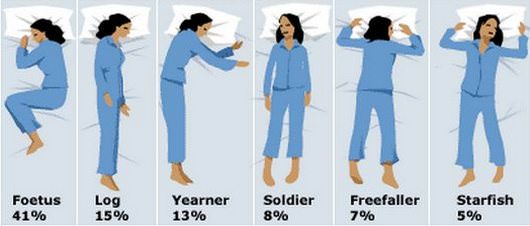What is The Best Sleep Posture for Lucid Dreaming?
Take a look at the best sleep postures for lucid dreaming, from fetal to lying on your back. With tips for both spontaneous and Wake Induced Lucid Dreams.
What is the best sleep posture for having lucid dreams?

The most popular sleep postures in the general population.
The folks at The Lucidity Institute are currently running a research study into sleep positions and their effects on conscious dreams.
Until the results are out, I thought I'd put my two cents into the mix and identify my own personal optimum sleeping positions for lucid dreaming.
This is not something I've kept track of over the years, but I can recall having more success with certain sleep postures over others.
First though, I should identify the two main types of lucid dreams because this could make a notable difference.
Dream Induced Lucid Dreams
Dream Induced Lucid Dreams (DILDs) are dreams that begin normally but give way to lucidity spontaneously through increased awareness.
Perhaps you see a flying pig and your well-trained brain spots it as a cue that you're dreaming... This can happen at any stage during the night but is much more likely during the final 2-3 hours of sleep when your REM periods are at their longest and dreams are most vivid.
I've woken up from many DILDs in the common fetal position (on my side, with my knees and elbows tucked in) as well as flat on my back. It can be strange to be walking around in a lucid dream one moment, then lying curled up in bed the next.
Occasionally I even wake myself up because I've moved my arm in the lucid dream and triggered my real life arm to move and hit the bed. This can be disorienting and cause a sudden shift in awareness from one body to the next.
If I stay completely still and close my eyes, I can sometimes return to the lucid dream from the same place I left off. This is known as Dream Chaining.
Wake Induced Lucid Dreams
Wake Induced Lucid Dreams (WILDs) are lucid dreams which you enter very deliberately as you fall asleep in bed, with no lapse in consciousness.
WILDs are the most vivid kind of lucid dreams. They allow you to choose your lucid landscape as you fall asleep consciously and recall your lucid dream intention.
This is a different kettle of fish and I think finding the best sleep posture for lucid dreaming matters much more in this instance.
My success with WILDs is universally down to lying on my back, despite the fact that this is not how I prefer to fall asleep. I find it the best posture to dissociate from my body (forget it exists and stop feeling it as sleep paralysis tales over) without my mind falling asleep. In essence, the perfect formula for a WILD.
Some lucid dreamers say back-sleeping isn't necessary for WILDs, but since I started out practicing Robert Monroe's OBE induction techniques I just find it the easiest way to relax every muscle group. Nowadays I more often use the 61-point relaxation technique which relies on the same corpse pose.
I also think this position creates a shallower breathing pattern which keeps you closer to consciousness as you sleep.
Once you have done this it may only be a matter of seconds until you can emerge mentally into the lucid dream world.
















